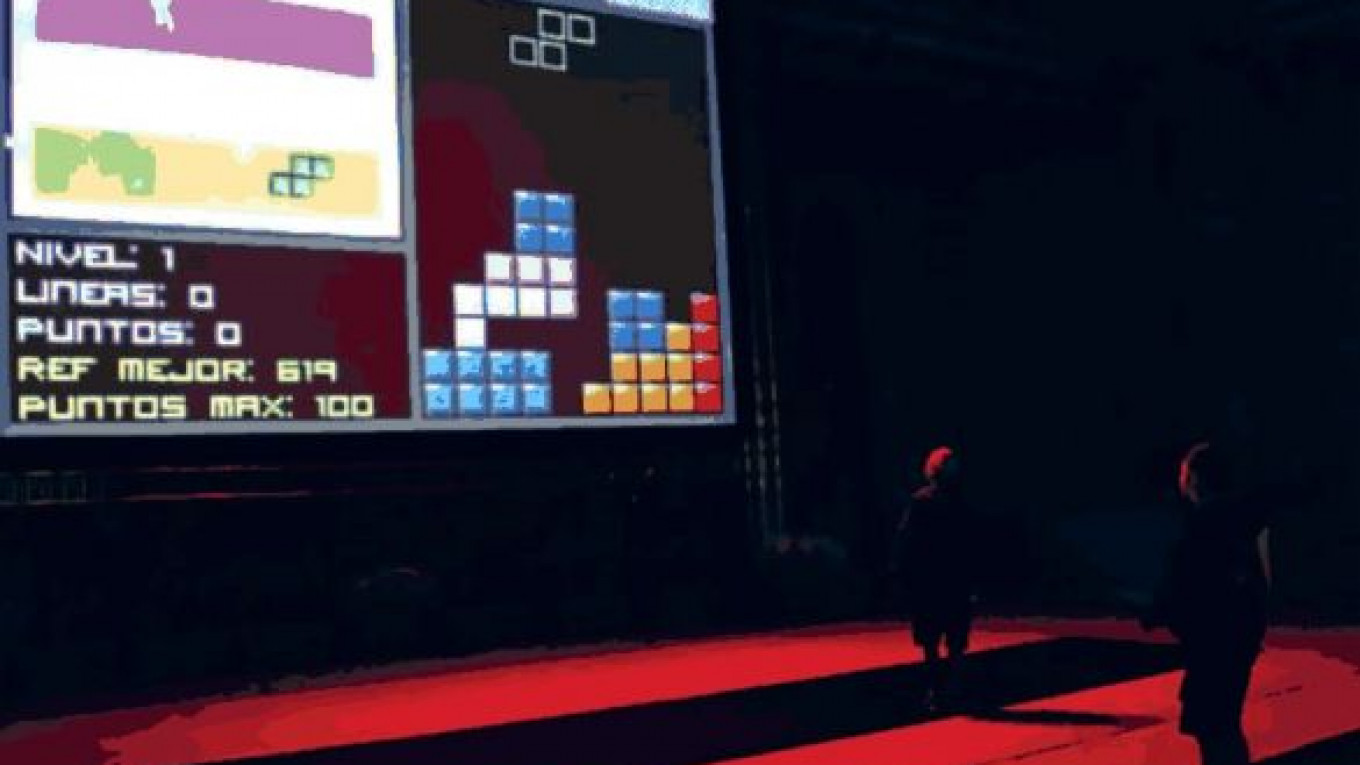All too many of you will be familiar with an addictive little Russian-born game called Tetris. You've played it alone on your digital devices, thumbs racing until that fateful L-piece hurtles down to finish the game. But is this the limit of the Tetris experience? Or could this most ubiquitous of games have unexplored potential?
"Game: The Future of Play," a new exhibit at the ZIL Cultural Center, has come all the way from Dublin, Ireland, to pose precisely these questions. The exhibit combines new technologies, twists on vintage video games, modern art, and even an out-of-body experience in attempts to challenge our most basic ideas of what games are and what it means to play them.
As you enter, an airy metallic structure invites visitors into one-on-one battles to colonize a field of biological cells. But there's a catch: to continue colonizing, you must steal pieces from the pairs around you. No game is an island, as visitors — or should we say, gamers — are flung into a new form of competition.
Further on, you encounter the apparently innocuous smartphone game "Generations." Then you realize — it is impossible to finish this game in a single lifetime. Could you enjoy a game that will outlive you? Who would you leave it to, and would they carry on your legacy?
And, of course, you'll find a surprising reincarnation of Tetris, which as it turns out isn't so small or solitary after all.
According to Irish Ambassador to Russia Philip McDonagh, this exhibit, a collaboration between the Dublin-based Science Gallery and Moscow's Polytechnic Museum, is a positive step for Russian-Irish relations.
"We have this concept of a partnership for modernization between Russia and the European Union, Russia and Ireland," the ambassador explained, "and we're always looking for ways of giving life to that idea."
What's more, "Game" could help to update Russia's perception of Irish culture. "A lot of people in Russia, they're aware of Ireland as a place for literature, music, and dance," McDonagh said. "[This project] helps to show a Russian audience that Ireland is a knowledge economy with high-tech in several sectors, with a scientific tradition."
Science Gallery, the pioneering institution at Trinity College that developed "Game," was opened to encourage this scientific potential in the face of a worldwide decline in the study of math and science. "The whole purpose of the Science Gallery is to excite young people about science," explained Professor Jane Ohlmeyer, Vice-Provost for Global Relations at Trinity.
Since its opening in 2008, the gallery has pulled in over a million visitors with its unusual blend of art and cutting-edge science — remember, the entire population of Ireland is less than five million. While a correlation hasn't been proven, the number of applications to study science at Trinity is on the rise.
What's the secret to Science Gallery's success? "It's all about interaction," Ohlmeyer explained, "it's all about exchange." The exhibits take on expansive topics such as light, water, or urban design and engage visitors through layers of interaction: with the individual works, with student demonstrators, and with each other.
It is this dynamic programming that drew the Polytechnic Museum into collaboration with Science Gallery. "[Game] is something on the edge between science, everyday life, psychology, art, and design," said Marina Semko of the Polytechnic Museum Development Foundation. "It's a very interesting experience for us, an experience that doesn't exist in Russia, and it would be good if we were able to do something similar."
The Polytechnic Museum, one of the oldest museums of science and technology in the world, is currently in the midst of a massive modernization project. Along with transforming the main exhibition space at Lubyanka, the project will establish a major educational and exhibition center on the Moscow State University campus devoted to encouraging future scientists and artists.
As for Science Gallery, "Game" might be just the beginning of its work in Moscow. Thanks to a 1 million euro ($1.3 million) gift from Google, Science Gallery International was established last year with the goal of founding 8 nodes across the world by 2020. A first node is already in development at Kings College, London, with more to come in New York, Bangalore, and Melbourne. Ultimately, each gallery in the network will produce unique exhibitions, highlighting their own country's scientific achievements, before sending them off on worldwide tours.
"We would love there to be a Science Gallery Moscow," said Ohlmeyer, adding that participation with the Polytechnic Museum would certainly be an option and that "a very high-powered university," such as Moscow State University, would have to support the project.
"Game: The Future of Play" (Igry: Vzglyad v Budushchee) will be on display until September 4 at the ZIL Cultural Center, 4 Vostochnaya Ulitsa, Metro Avtozavodskaya.
Contact the author at artsreporter@imedia.ru
A Message from The Moscow Times:
Dear readers,
We are facing unprecedented challenges. Russia's Prosecutor General's Office has designated The Moscow Times as an "undesirable" organization, criminalizing our work and putting our staff at risk of prosecution. This follows our earlier unjust labeling as a "foreign agent."
These actions are direct attempts to silence independent journalism in Russia. The authorities claim our work "discredits the decisions of the Russian leadership." We see things differently: we strive to provide accurate, unbiased reporting on Russia.
We, the journalists of The Moscow Times, refuse to be silenced. But to continue our work, we need your help.
Your support, no matter how small, makes a world of difference. If you can, please support us monthly starting from just $2. It's quick to set up, and every contribution makes a significant impact.
By supporting The Moscow Times, you're defending open, independent journalism in the face of repression. Thank you for standing with us.
Remind me later.






